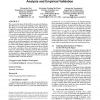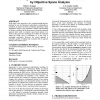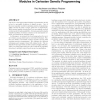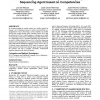GECCO
2008
Springer
14 years 19 days ago
2008
Springer
The paper presents the parameter-less implementation of an evolutionary-based search. It does not need any predefined control parameters values, which are usually used for geneti...
GECCO
2008
Springer
14 years 19 days ago
2008
Springer
The crossover bias theory for bloat [18] is a recent result which predicts that bloat is caused by the sampling of short, unfit programs. This theory is clear and simple, but it ...
GECCO
2008
Springer
14 years 19 days ago
2008
Springer
In this paper, a multiobjective (MO) learning approach to image feature extraction is described, where Pareto-optimal interest point (IP) detectors are synthesized using genetic p...
GECCO
2008
Springer
14 years 19 days ago
2008
Springer
In this paper a new approach to solve constrained multi-objective problems by way of evolutionary multi-objective optimization is introduced. In contrast to former evolutionary ap...
GECCO
2008
Springer
14 years 19 days ago
2008
Springer
The choice of an appropriate hardware representation model is key to successful evolution of digital circuits. One of the most popular models is cartesian genetic programming, whi...
GECCO
2008
Springer
14 years 19 days ago
2008
Springer
GECCO
2008
Springer
14 years 19 days ago
2008
Springer
This paper introduces a new approach to develop a fast gait for quadruped robot using genetic programming (GP). Several recent approaches have focused on the genetic algorithm (GA...
GECCO
2008
Springer
14 years 19 days ago
2008
Springer
In e-learning initiatives content creators are usually required to arrange a set of learning resources in order to present them in a comprehensive way to the learner. Course mater...
GECCO
2008
Springer
14 years 19 days ago
2008
Springer
This paper describes a speciation method that allows an evolutionary process to learn several robot behaviors using a single execution. Species are created in behavioral space in ...
GECCO
2008
Springer
14 years 19 days ago
2008
Springer
This article arguments that rank correlation coefficients are powerful association measures and how can they be adopted by EDAs. A new EDA implements the proposed ideas: the Non-P...





